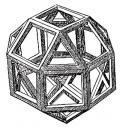Theatre of the absurd
From The Art and Popular Culture Encyclopedia
|
"The Theatre of the Absurd attacks the comfortable certainties of religious or political orthodoxy. It aims to shock its audience out of complacency, to bring it face to face with the harsh facts of the human situation as these writers see it. But the challenge behind this message is anything but one of despair. It is a challenge to accept the human condition as it is, in all its mystery and absurdity, and to bear it with dignity, nobly, responsibly; precisely because there are no easy solutions to the mysteries of existence, because ultimately man is alone in a meaningless world. The shedding of easy solutions, of comforting illusions, may be painful, but it leaves behind it a sense of freedom and relief. And that is why, in the last resort, the Theatre of the Absurd does not provoke tears of despair but the laughter of liberation."--Absurd Drama (1965) by Martin Esslin |
.png)
|
Related e |
|
Featured: |
The theatre of the absurd is a post–World War II designation for particular plays of absurdist fiction written by a number of primarily European playwrights in the late 1950s. It is also a term for the style of theatre the plays represent. The plays focus largely on ideas of existentialism and express what happens when human existence lacks meaning or purpose and communication breaks down. The structure of the plays is typically a round shape, with the finishing point the same as the starting point. Logical construction and argument give way to irrational and illogical speech and to the ultimate conclusion—silence.
The term was coined by the critic Martin Esslin, who made it the title of a 1962 book on the subject. Esslin saw the work of these playwrights as giving artistic articulation to Albert Camus' philosophy that life is inherently without meaning, and so one must find one's own meaning as illustrated in his work The Myth of Sisyphus.
The 'Theatre of the Absurd' is thought to have its origins in Dadaism, nonsense poetry and avant-garde art of the 1910s – 1920s. Despite its critics, this genre of theatre achieved popularity when World War II highlighted the essential precariousness of human life.
The expression "Theater of the Absurd" has been criticized by some writers, and one also finds the expressions "Anti-Theater" and "New Theater". According to Martin Esslin, the four defining playwrights of the movement are Eugène Ionesco, Samuel Beckett, Jean Genet, and Arthur Adamov, although each of these writers has entirely unique preoccupations and techniques that go beyond the term "absurd". Other writers often associated with this group include Tom Stoppard, Friedrich Dürrenmatt, Fernando Arrabal, Harold Pinter, Edward Albee and Jean Tardieu. Playwrights who served as an inspiration to the movement include Alfred Jarry, Luigi Pirandello, Stanislaw Ignacy Witkiewicz, Guillaume Apollinaire, the surrealists and many more.
The plots of many absurdist plays feature characters in interdependent pairs, commonly either two males or a male and a female. Some Beckett scholars call this the "pseudocouple". The two characters may be roughly equal or have a begrudging codependency (like Vladimir and Estragon in Waiting for Godot or the two main characters in Rosencrantz & Guildenstern Are Dead); one character may be clearly dominant and may torture the passive character (like Pozzo and Lucky in Waiting for Godot or Hamm and Clov in Endgame); the relationship of the characters may shift dramatically throughout the play (as in Ionesco's The Lesson or in many of Albee's plays, The Zoo Story for example).

